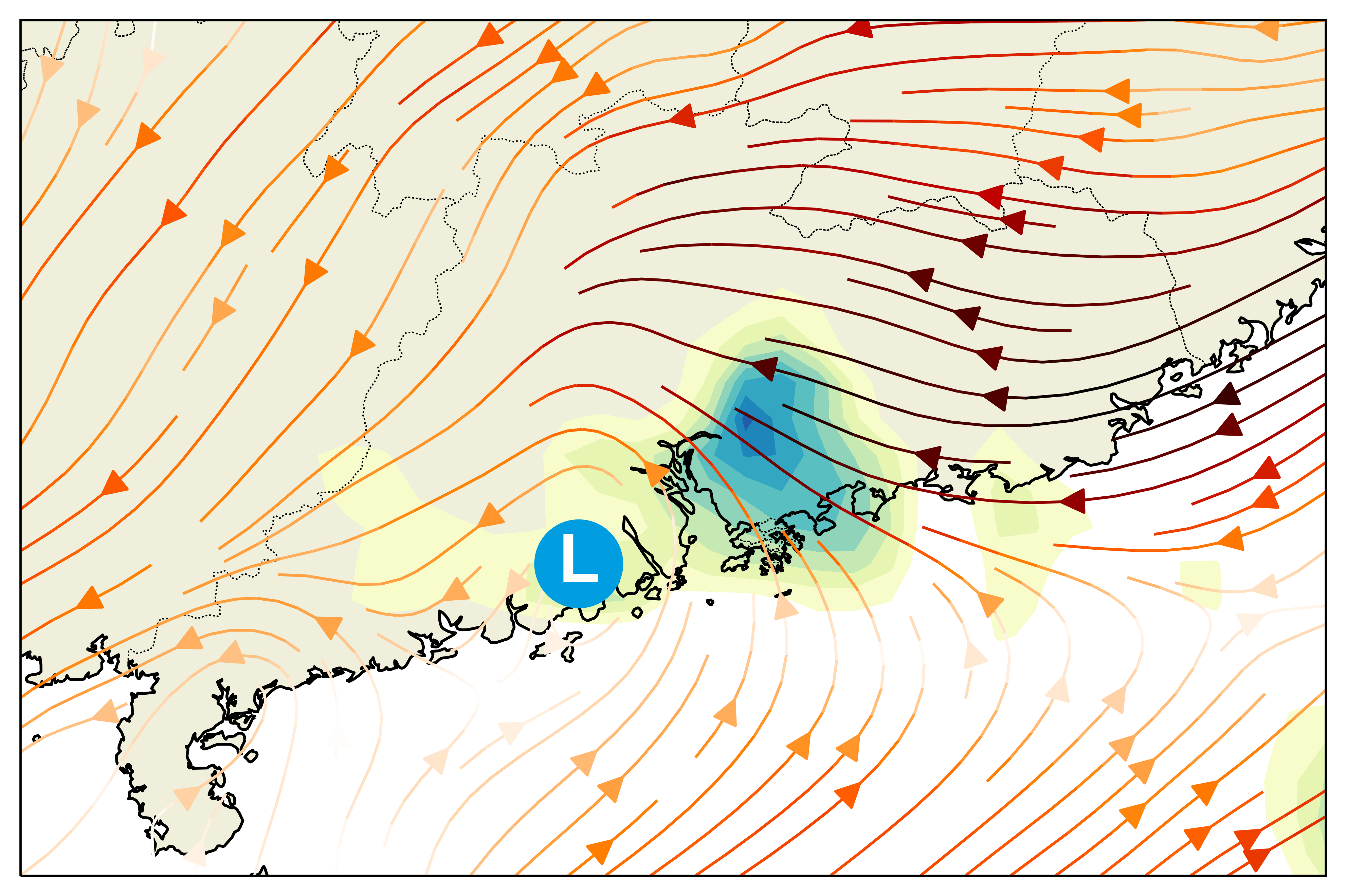
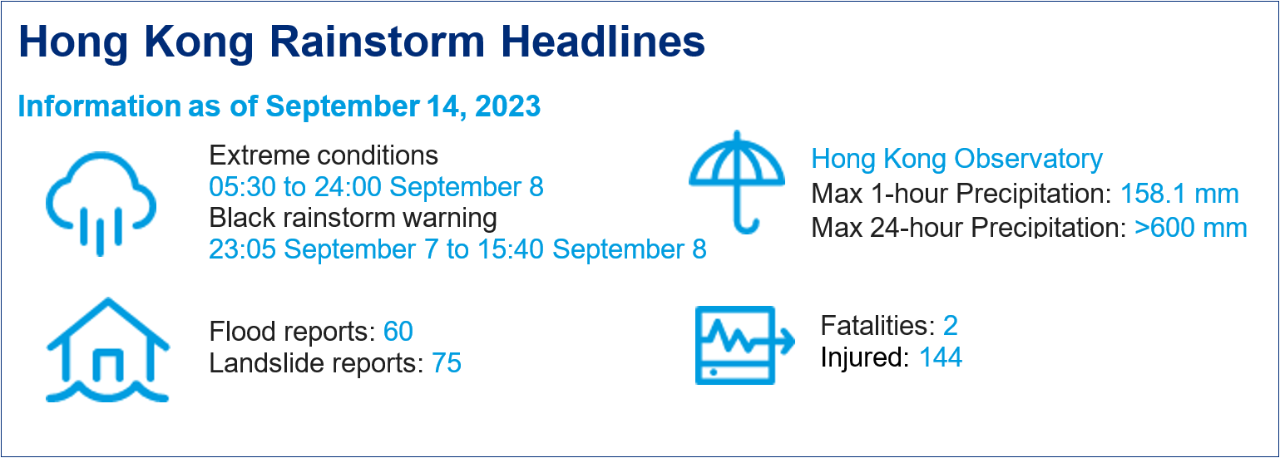
- Maximum 1-hour rainfall of 158.1 mm reached the highest record since 1884.
- Black rainstorm warning was in force for 16.5 hours, the longest since its establishment in 1992.
- Widespread flooding occurred across Hong Kong, as shopping malls and car parks filled with rainwater.
- Cities in the Greater Bay Area also experienced heavy rainstorms of over 250 mm in 24 hours.
Hong Kong Flood post-event report comprises the following sections:
- Meteorological Background
- Damage Impacts
- Historical Rainstorm Event
- Hong Kong’s Flood Defense
- Large Industry Insured Losses
Meteorological Background
The western North Pacific typhoon season was very active in late August 2023, with 4 tropical cyclone formations in a week. On August 28, a tropical low northwest of Guam was upgraded to tropical storm and named Haikui. The storm moved mostly westward and gradually intensified over the open Pacific. Haikui struck Taiwan’s southeast coast on September 3, with a maximum wind speed estimated to be 155 kph, according to Taiwan’s Central Weather Bureau. It crossed the island of Taiwan and exited on its southwest side. Haikui continued tracking westward and made landfall around the border of Fujian and Guangdong as a tropical storm on September 5.
After landing in mainland China, Haikui further weakened, and its remnant transitioned into a low-pressure trough. On September 7, the system moved to the area of the Pearl River Delta. The trough drew in tropical moisture from the southwest, meeting with the easterly monsoon. The convergence of these 2 airstreams triggered widespread heavy rainfall in the region (Figure 1).
Figure 1: Near surface winds (arrows) and perceptible water (shading) at 20:00 HKT, September 7, 2023. “L” indicates the location of Haikui’s remnant
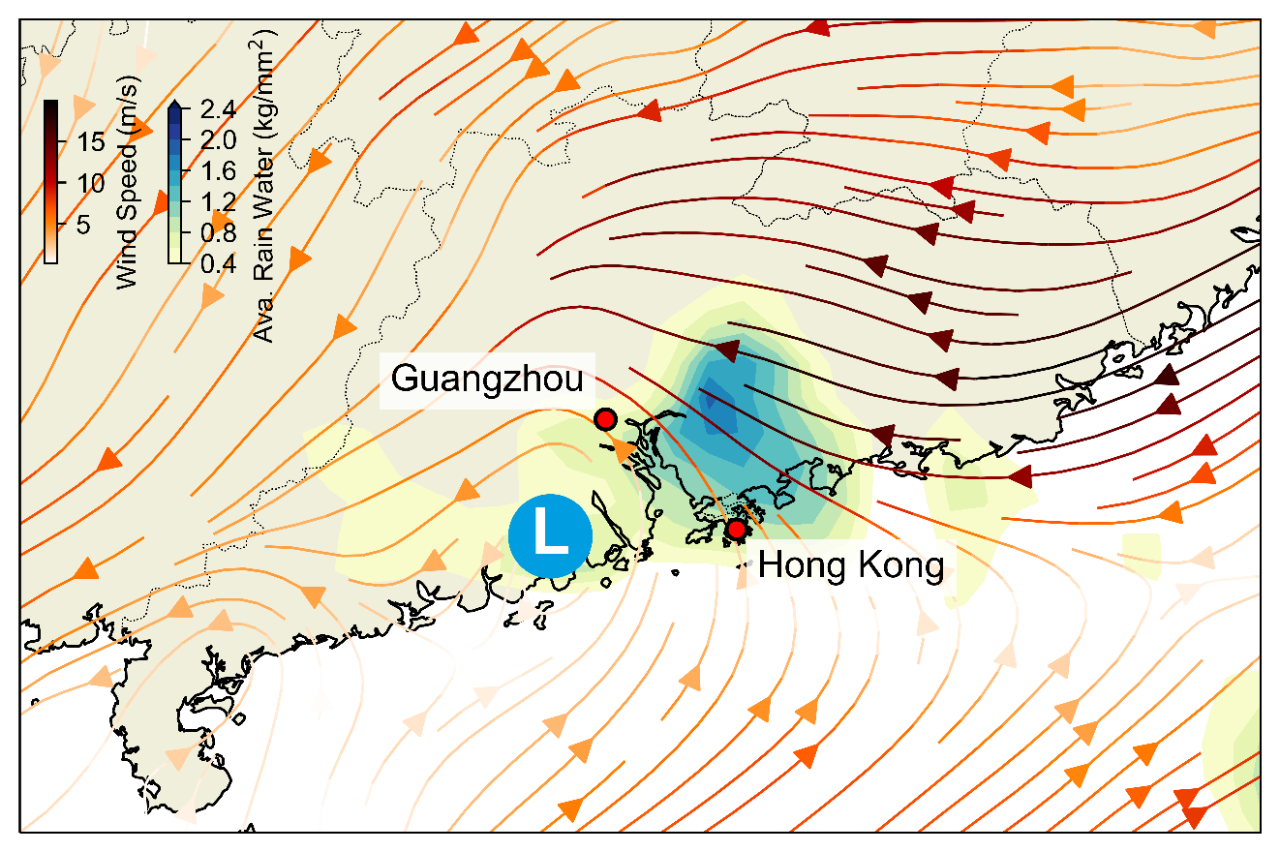
Source: ECMWF Reanalysis 5 Graphic: Guy Carpenter
The Hong Kong Observatory weather station observed a 1-hour rainfall of 158.1 mm at 00:00 HKT on September 8, the heaviest hour since recording began in 1884. Most of the territories had received more than 600 mm rainfall in 24 hours by 10:00, with part of Hong Kong Island exceeding 800 mm (Figure 2). The unprecedented amount of rain triggered significant flooding across the city.
Figure 2: Hong Kong 24-hour rainfall received at 10:00 HKT, September 8, 2023.
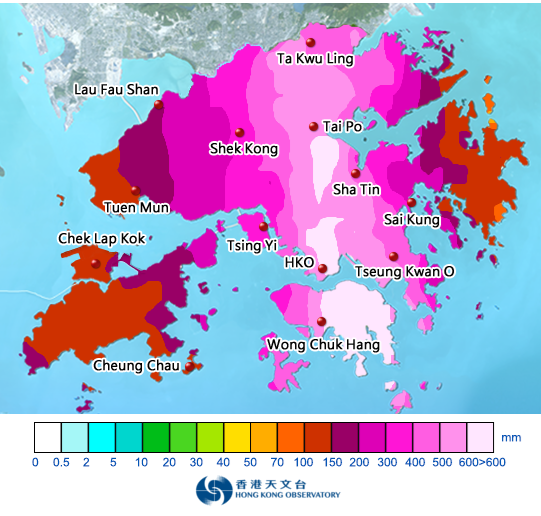
Source: Hong Kong Observatory
Most of the Greater Bay Area cities also experienced heavy rainfall on the same night (Figure 3). Stations in Foshan, Guangzhou, and Dongguan observed 24-hour rainfall near or above 400 mm. In Shenzhen, Hong Kong’s neighboring city, over 500 mm of rainwater had fallen. It was the heaviest rainstorm to occur since 1952, with widespread flooding reported.
Figure 3: Guangdong 24-hour rainfall received at 12:00 HKT, September 8, 2023.
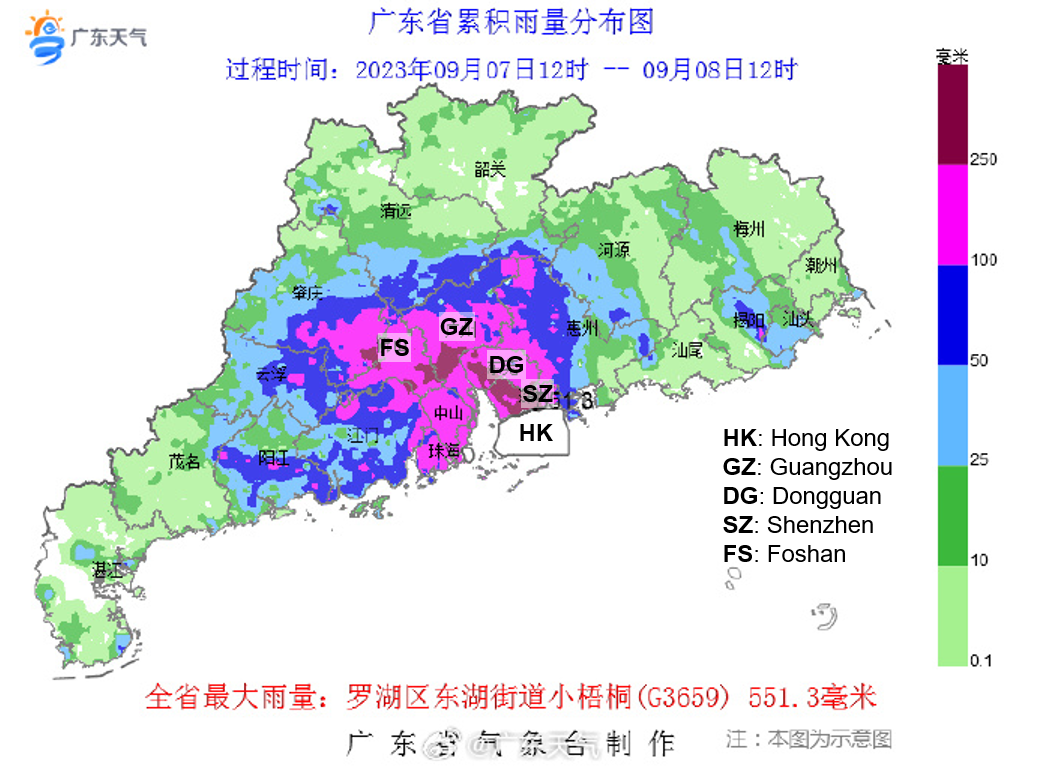
Source: Guangdong Meteorological Service
Damage Impacts
Hong Kong
Hong Kong Observatory first issued an Amber Rainstorm Warning Signal at 21:25 HKT on September 7, and raised the warning to the highest level (black) at 23:05. A Special Announcement on Flooding in the northern New Territories and a Landslip Warning were issued later at 19:50 and 23:45, respectively. Because of severe flooding, the Hong Kong government declared an “extreme condition” at 05:30 on September 8, which lasted until midnight.
The heavy rainstorm caused city-wide flash floods and landslides. The government received 60 flooding and 75 landslide reports by September 10. About 80 roads across the city were damaged or blocked.
Some notable local impacts are listed below, and Figure 4 shows the affected districts:
Property
- Rainwater half-filled a car park and a shopping center at Wan Tsui Estate in Chai Wan.
- A shopping center in Quarry Bay was flooded.
- Landslides in Tai Tam endangered 3 luxury houses.
- Landslides occurred at Yiu Tung Estate in Shau Kei Wan.
- Landslides near Cha Kwa Ling village in Lam Tin caused 200 residents to evacuate.
- The basement of Temple Mall North, a shopping center in Wong Tai Sin, was flooded with rainwater.
Transportation
- The Wong Tai Sin MTR Station was closed because of flooding.
- Sections of the Kwun Tong Line were suspended because of flooding and power disruption.
- More than 20 buses were stuck on roads because of heavy rain, and bus services were suspended the morning of September 8.
- Landslides damaged the only access route to the rural village of Shek O; 120 residents were evacuated.
Agriculture
- More than 1,000 pigs drowned at a pig farm in Ta Kwu Ling, with an estimated loss exceeding HKD 3 million.
Shenzhen
- Widespread flooding was reported; 6 subway lines were suspended.
Figure 4: Districts with notable damages.
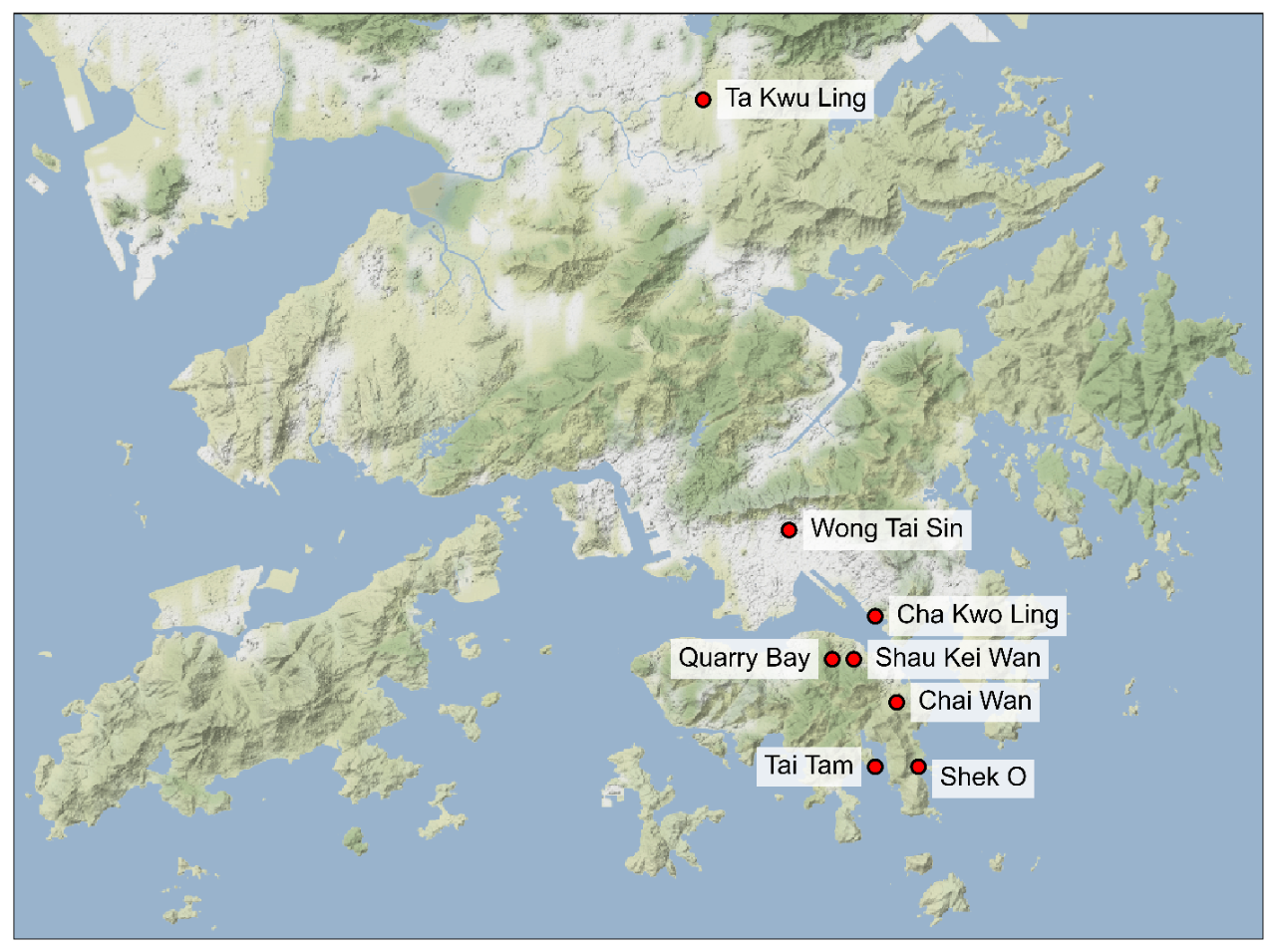
Source: News releases; Graphics: Guy Carpenter
Historical Rainstorm Events
Heavy rainstorms are not rare occurrences in Hong Kong. As a result of substantial flood-prevention investments, the number of casualties has declined greatly over the years (Table 1). Hong Kong Federation of Insurers (HKFI) reported that the rainstorm in 2008 incurred claims of HKD 237 million.
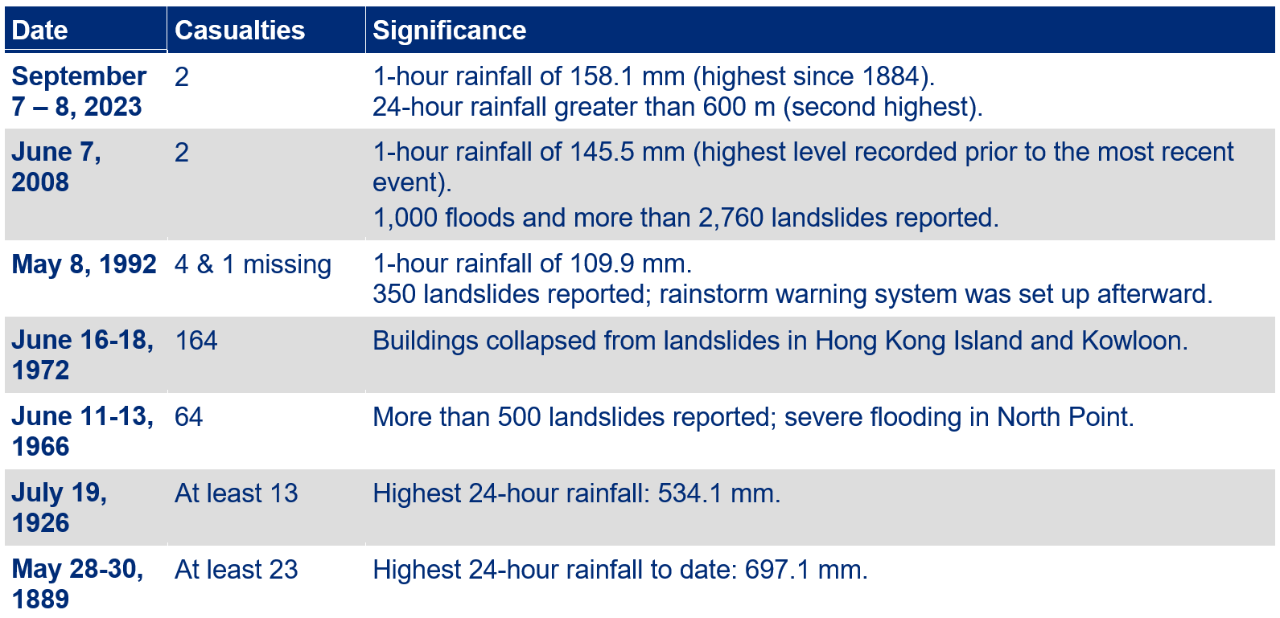
Source: Climate Challenge, PCMarket Magazine
Hong Kong’s Flood Defense
Hong Kong receives an average of 2,400 mm rainfall per year. Heavy rainstorms in a short period can cause flooding across the region, especially in low-lying rural areas, natural flood plains, and older urban areas. The Drainage Services Department was set up in 1989 for flood prevention and sewage management. Several long-term improvement measures have been implemented for flood defense. Current drainage systems are designed for 10- to 50-year rainstorms for rural areas, and 50- to 200-year rainstorms for urban areas.
In rural areas, natural rivers were straightened, widened, deepened, and installed with linings to increase their capacity. For low-lying villages, embankments were built to protect them, and stormwater was pumped to outside drainage channels.
In urban areas, a “three-pronged flood prevention strategy” was implemented: upstream interception, flood storage, and downstream local drainage improvement (Figure 5).
Four drainage tunnels (including the Kai Tak Transfer Scheme and Hong Kong West, Lai Chi Kok, and Tsuen Wan Drainage Tunnels) spanning about 21 km were built to divert stormwater to rivers or the sea.
Stormwater storage tanks at Tai Hang Tung, Sheung Wan, Happy Valley, and On Sau Road collect water temporarily to alleviate the burden of downstream drainage systems. Another 5 extra tanks are being planned.
Local drainage improvements also were carried out to increase river capacity and enlarge or construct new underground drains. Over 100 km river sections and 90 km drains have been upgraded to date.
Figure 5: Conceptual layout of the three-prong flood prevention strategy
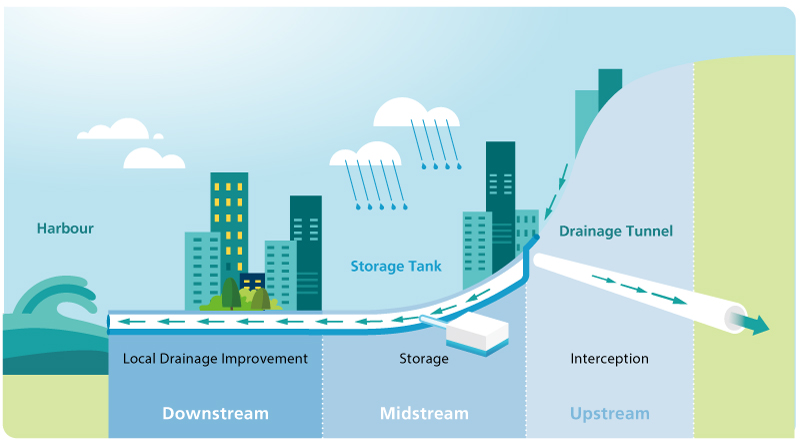
Source: Drainage Services Department
These infrastructure investments have mitigated damages from heavy rainfall, allowing Hong Kong to return to normal economic activities shortly after a flooding event. For example, the city’s MTR subway system resumed operation on all lines on September 9.
Large Industry Insured Losses
Tropical cyclones and monsoon troughs are frequent in Hong Kong and can bring heavy precipitation. The rainstorm between September 7 and 8 was equivalent to 1/4 the annual average. Two recent weather events involving large claims were Super Typhoon Mangkhut and Hato. Below are their incurred claim amounts as reported by the Hong Kong Federation of Insurers (HKFI).
Table 2: Incurred claims for Mangkhut and Hato.

Source: HKFI
Many will remember the huge number of fallen trees in the aftermath of Mangkhut, as well as the broken-glass debris from the Two Harbourfront office tower in Hung Hom, which generated a substantial single-building risk loss. Since that time, insurers have raised policy excess levels. Although the recent rainstorm in Hong Kong did not generate this type of severe wind damage, its significant damages focus attention on several issues of importance. In particular, since rain-driven events can cause large motor losses, it is important to note that, according to the latest statistics from the Hong Kong Insurance Authority, the motor protection gap has widened recently as both the total number of cars increased and the proportion of private cars with comprehensive coverage decreased (from 47% in 2017 to 43% in 2021). Furthermore, many homeowners and small and medium enterprises that currently do not have property insurance are likely to reassess their purchase decisions. In short, all segments of society can learn from this storm and consider improvements in warning systems, flood defenses, and insurance risk transfer for greater financial resilience.
POST EVENT: HONG KONG RAINSTORM
Sources: Hong Kong Observatory, Guangdong Meteorological Services, Hong Kong SAR Drainage Services Department, Hong Kong Federation of Insurers, Hong Kong Insurance Authority, South China Morning Post, PCMarket Magazine, Radio Television Hong Kong, Xinhua News, Taiwan Central Weather Bureau, Central European Centre for Medium-Range Weather Forecasts (ECMWF)
This publication / website / product / service contains information that is copied or extracted from data made available in publications of the Hong Kong Observatory (the "Observatory"). The provision of the information copied or extracted from the Observatory's publications shall not be constituted as any form of co-operation or affiliation by the Observatory with any person in relation to this publication / website / product / service or any contents herein. Nothing in this publication / website / product / service shall give rise to any representation, warranty or implication that the Observatory agrees with, approves of, recommends or endorses this publication / website / product / service. The Observatory does not have any liability, obligation or responsibility whatsoever for any loss, destruction or damages (including without limitation consequential loss, destruction or damages) howsoever arising from or in respect of your use or misuse of or reliance on or inability to use any contents herein.